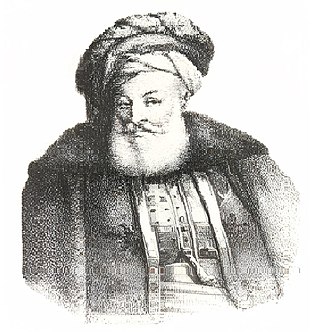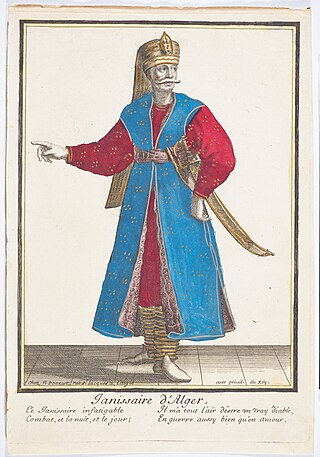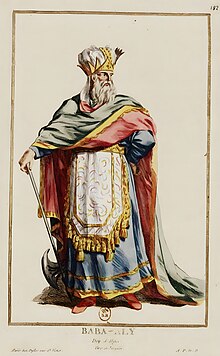
The Regency of Algiers was a largely independent tributary state of the Ottoman Empire during the early modern period, located on the Barbary Coast of North Africa from 1516 to 1830. Founded by the corsair brothers Aruj and Hayreddin Barbarossa, the Regency was a formidable pirate base infamous for its corsairs. First ruled by Ottoman viceroys, it later became a sovereign military republic that plundered and waged maritime holy war against European Christian powers.

Ahmed Bey ben Mohamed Sherif, also known as Ahmed Bey or Hadj Ahmed Bey was the last bey of Constantine in the Regency of Algiers, ruling from 1826 to 1848. He was the successor of Mohamed Menamenni Bey ben Khan. As head of state, he led the local population in a fierce resistance to the French occupation forces. With the position vacant, in 1833 he adopted the title of leader of Algeria, and dey in exile، although this was not recognized by any other country. In 1837 Constantine was taken by the French after an intense siege. He retreated into the Aurès Mountains from where he continued to wage a low-intensity conflict with tribes still loyal to him, until he capitulated in 1848.

Mohamed Bey El Mouradi was a Muradid leader and Bey of Tunis from 1675 until his death in 1696. He was the eldest son of Murad II Bey.

Ali V Ben Ahmed, nicknamed Ali Khodja, Ali-Meguer, or Ali Loco was a Kouloughli of partial Georgian (Mengrelian) and Native Algerian origins born in Algeria. He was the dey of the Deylik of Algiers from September 1817, just after the assassination of his predecessor Omar Agha the 8th. He remained so until his death in February 1818. His sobriquet Ali-Meguer may indicate his Mingrelian background.
Ibrahim Bey, of his name Ibrahim Bey El-Greitli, chief of the Haraktas, was a bey of the province of Constantine, who reigned from July 1822 to December 1824. He was of Turkish origin.

The Revolutions of Tunis or the Muradid War of Succession was a period of troubles and civil wars in Ottoman Tunisia. It ran from the death of the Muradid sovereign Murad II Bey in 1675 until the seizure of power by the Husainid sovereign Al-Husayn I ibn Ali at-Turki in 1705. The belligerents were Ali Bey al-Muradi and Muhammad Bey al-Muradi, their uncle Muhammad al-Hafsi al-Muradi, several Deys of Tunis, the Turkish militia in Tunis and the Dey of Algiers.
The Dey of Tunis was the military commander of the janissaries in the regency of Tunis. In the seventeenth century the holders of the position exercised varying degrees of power, often near-absolute. Until 1591 the Dey was appointed by the Ottoman governor (“Pasha”). In 1673 the Dey and the janissaries revolted against Murad II Bey and were defeated. After this the hereditary position of Bey was pre-eminent in Tunis. The position of Dey continued to exist until it was abolished by Sadok Bey in 1860.

The Odjak of Algiers((efn|also spelled Ujaq was a unit of the Algerian army. It was a highly autonomous part of the Janissary Corps, acting completely independently from the rest of the corps, similar to the relationship between Algiers and the Sublime Porte. Led by an Agha, they also took part in the country's internal administration and politics, ruling the country for several years. They acted as a defense unit, a Praetorian Guard, and an instrument of repression until 1817.

The Beylik of Constantine, Beylik of the Sunrise or Beylik of the East as was its official designation, was one of the three Beyliks of the Regency of Algiers . The region liberated itself from the Hafsid Emirate of Béjaïa in the early 16th century, and constituted itself around Constantine in the mid to late 16th century. The Beylik collapsed in the 1837 siege of Constantine during the French conquest of Algeria. The Constantine department was formed upon the bases of the Beylik in 1848.
Mohamed ben Hassan, also known as Muhammad III was during the reign of Baba Ali Chaouch khaznaji of Algiers before becoming Dey of Algiers from 1718 to 1724 as successor to Baba Ali I.

The Tunisian–Algerian war of 1694 was a conflict between the Deylik of Algiers, and the Regency of Tunis.
The Maghrebi war (1699–1702) was a conflict involving a Tunisian, Tripolitanian, and Moroccan coalition, and the Deylik of Algiers. It was an important milestone in the further weakening of the already fragile Ottoman grip over the Maghreb, as both sides utterly ignored the Ottoman sultan's pleas to sign a peace treaty. This war also led to the renewal of the Muradid infighting, which would later lead to the establishment of the Beylik of Tunis, and the Husainid dynasty in 1705.
The siege of Tunis was a siege fought in 1694, between the Deylik of Algiers, and Muradid Tunis, during the Tunisian-Algerian War of 1694.
The Constantine campaign was launched by Bey of Tunis Murad III Bey in 1699 to capture the Beylik of Constantine, situated in the east of the Deylik of Algiers.
The Tunisian–Algerian War of 1705 was a conflict between the Regency of Algiers and the Regency of Tunis.

Dey Hadj Ahmed Chabane was the fourth Dey of Algiers. He ruled from 1688 to 1695, and was the first member of the Algerian Janissary Odjak to ever assume this position. Under his leadership, Algeria enjoyed good relations with France. His military campaigns against Morocco and Tunis were successful. However, his enemies turned his Eastern army against him; he was removed from power and executed.
Hadj Hassen-Chaouch or Baba Hassen-Chaouch was the 6th ruler and Dey of Algiers. He ruled just a couple of months between 1698 and 1700.
Hadj Mustapha was the 7th ruler and Dey of Algiers. He ruled five years after his predecessor Hadj Chaouch.










